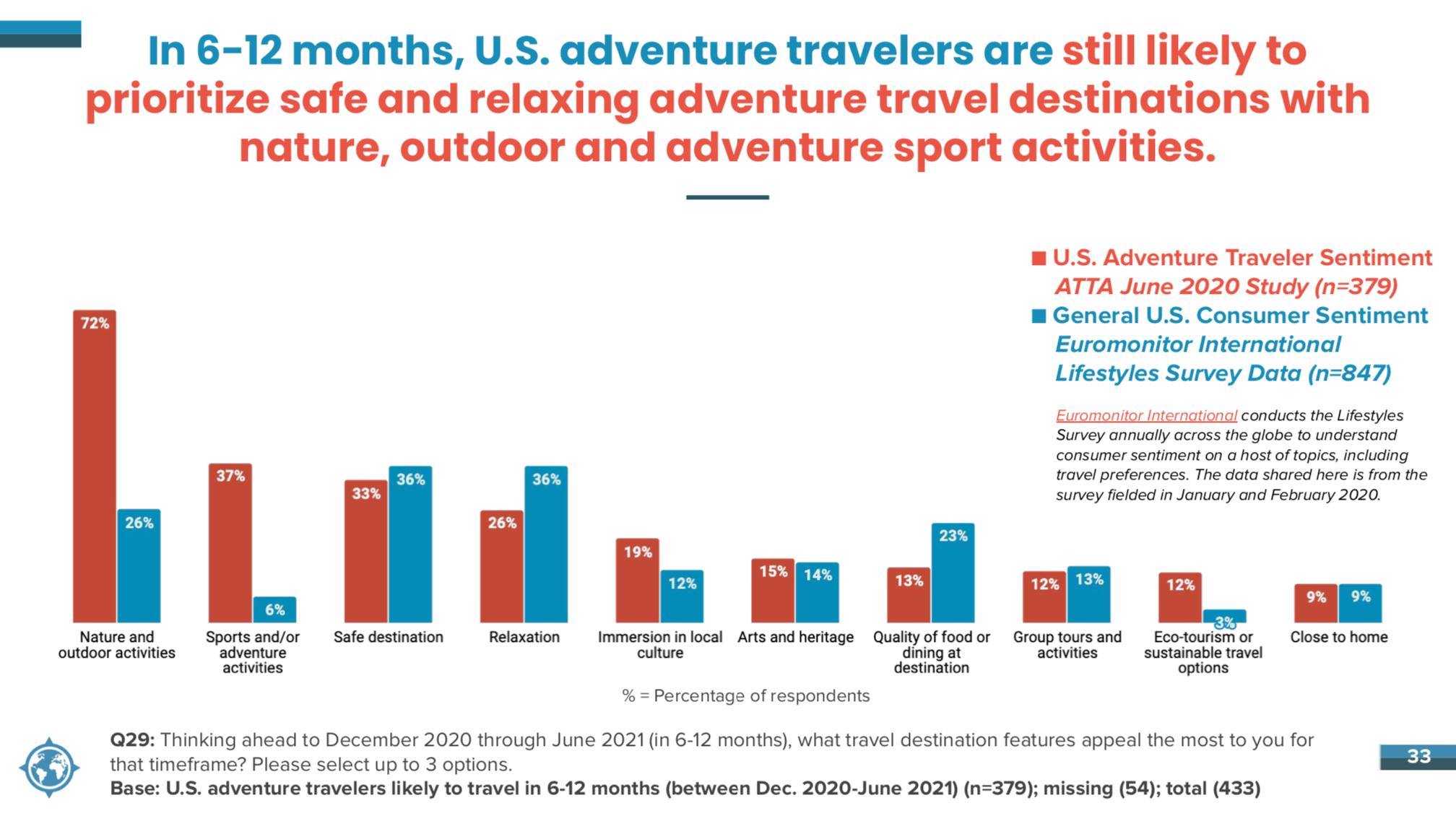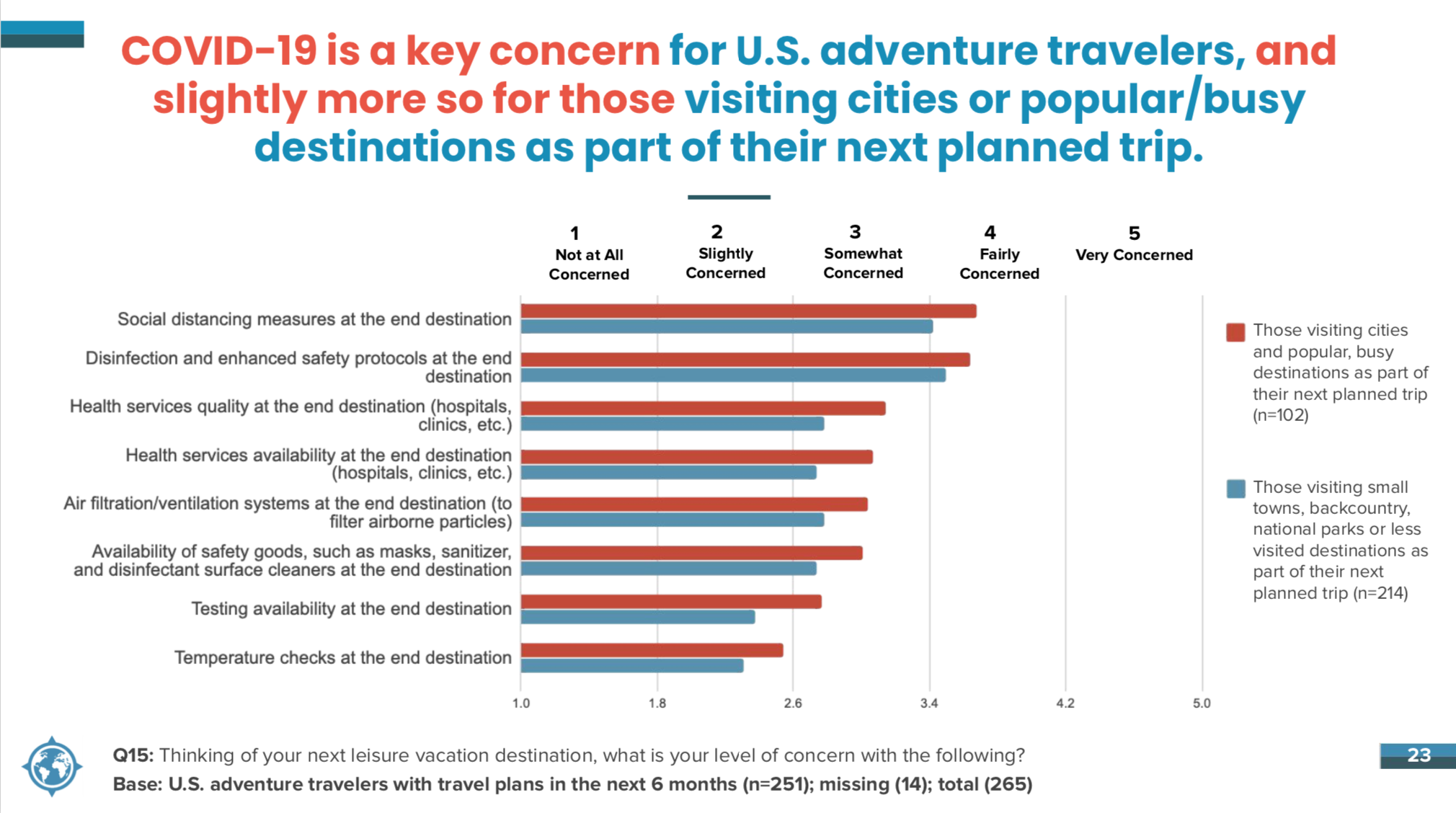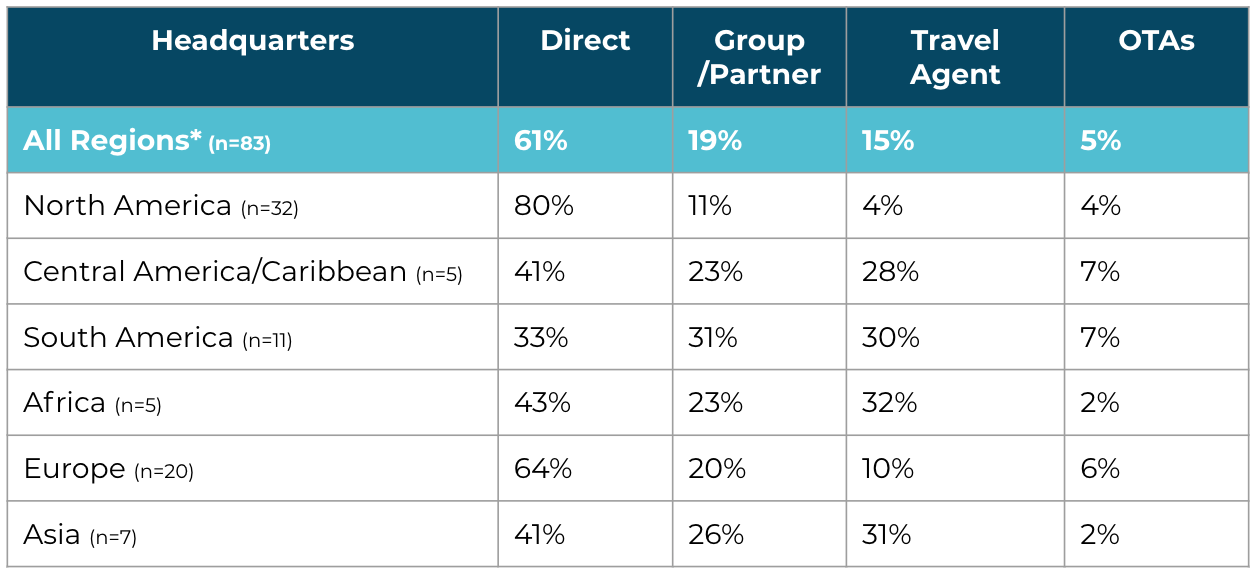In late September 2020, the World Travel and Tourism Council (WTTC) partnered with Oliver Wyman to release a report entitled To Recovery & Beyond: The Future of Travel & Tourism in the Wake of COVID-19. The report includes extensive data-driven research and details on the impact COVID-19 has had and will continue to have on the global travel industry. The trends and policy recommendations highlighted in the report are very useful guidelines that can be applied to all areas of the tourism industry.
It is important to understand the implications of these trends in order to offer guidance on how to emerge from this pandemic. On a positive note, adventure travel is already prepared and ideally positioned to respond quickly through its current strengths—a focus on the outdoors and travelers who seek to get back to their passions such as hiking, biking, diving, climbing, rafting, and more.
Trends
Demand Evolution
WTTC’s report notes that, “Traveller preferences and behaviours have shifted toward the familiar, predictable, and trusted. Domestic vacations, extensive planning, and the outdoors will reign in the short-term, with tourism businesses and destinations already adapting.”This finding matches evidence from the Adventure Travel Trade Association (ATTA)’s U.S. Adventure Traveler Sentiment - June-July 2020 Report, released in late July 2020. As of June/July 2020, 63% of U.S. adventure travelers were planning on traveling domestically on their next planned trip. The same travelers are seeking safe and relaxing destinations with nature, outdoor, and adventure activities. In fact, this survey found that 72% of adventure travelers are planning on doing nature and outdoor activities on their next trip, specifically hiking/trekking/walking, cycling (road/paved surface), and camping.

According to ATTA’s report mentioned previously, adventure travelers also often visit the countryside (rural areas), small towns/villages/resort communities, and national and state parks and reserves, all ideal destinations for social distancing. In fact, respondents stated that they are more likely to visit national and state parks and reserves, rarely visited destinations and sites that are accessible but not commonly visited, and remote destinations. Following this trend, they are less likely to visit cities/urban areas and popular/busy destinations.
When it comes to tour operators, U.S. adventure travelers expect them to customize and modify itineraries to enhance safety. This can be done through small group trip options, social distancing measures on group tours, avoiding generally crowded areas, and limiting unnecessary face-to-face interactions between staff, guests, and locals. In addition to these itinerary modifications, guests expect expanded health and hygiene measures to be taken.
Health & Hygiene
According to the WTTC report, “Health, safety and trust are paramount in this new era. Personal experiences, the fear of being stuck in another country, and concerns for distancing will guide consumer behaviour in the short- to mid-term. Businesses will have to collaborate even more closely with their extended value chains to ensure readiness.”
This again matches findings from ATTA’s U.S. Adventure Traveler Sentiment - June-July 2020 Report. U.S. adventure travelers are concerned about COVID-19, but the level of concern is lower for those visiting more remote destinations.

The most common precautions all adventure travelers are looking for from their end destination include social distancing measures and enhanced safety protocols. To reach this goal, adventure travelers expect businesses to adequately equip and provide resources and training to their staff and guides; publish enhanced safety protocols on their website, including what will happen to travelers if they show any symptoms; implement enhanced safety protocols; ensure all suppliers they work with to also adhere to enhanced safety standards and protocols, and decrease the use of shared resources and equipment with the aim to prevent virus spread. Overall, adventure travelers expect transparent and timely COVID-19 related communications, flexible cancellation and refund policies, and contactless transaction options as often as possible.
As with the demand evolution trends discussed above, adventure travel is well-suited to this requirement. In addition to the prevalence of activity opportunities allowing for social distancing, multiple reputable organizations have created guidelines for adventure companies to improve and refine their health and safety measures. WTTC’s Safe Travels Global Protocols and Stamp initiative is one important way travel organizations can demonstrate their commitment to safety. The WTTC’s adventure travel specific protocols were informed by and align with ATTA’s Health & Safety Guidelines. ATTA offers guidelines for ten different adventure travel activities at no cost, along with a digital badge for operators to show their adherence. For adventure companies looking for more formal education, ATTA’s online Safety & Risk Management course is designed to take adventure travel operators and managers through the complete process of setting up and running a safety management system in their operation.
Innovation & Digitization
The WTTC report found that “COVID-19 is proving to be an unexpected catalyst in the Travel & Tourism sector’s quest for innovation and the integration of new technologies. Amid stay-at-home orders, digital adoption and consumption are on the rise, with consumers now expecting contactless technologies, among others, as a basic prerequisite for a safe and seamless travel experience.”
The trend toward technology adoption is nothing new in the travel industry; even before COVID-19, adventure tour operators were responding to this need. In ATTA’s 2019 Industry Snapshot Report, 50% of respondents stated they had an online reservation system that took credit cards; in the 2020 Industry Snapshot Report (to be released in December 2020), this number increased to 60%. The report also found that the percentage of bookings received through online distribution systems varies:

Technology is only going to increase in importance; however, adventure travel still has opportunities to improve in this area. Many technological solutions exist. ATTA payment partner Flywire, for example, offers flexible ways to accept online payments while reducing associated costs and fees for the merchant.
Sustainability
The final trend identified in the WTTC report says, “From widespread unemployment and anti-racism movements to the restoration of natural habitats, the world has been reinvigorated to tackle social, environmental, and institutional sustainability. In particular, heightened public awareness of wildlife markets and poaching has boosted advocacy for wildlife protection.”
Again, adventure travel is ideally positioned for this trend. ATTA’s upcoming 2020 Industry Snapshot report (to be released in early December) found that even before COVID-19, adventure travel demand has been trending toward greener, more sustainable, low-impact itineraries. ‘Slow travel’ itineraries have also been increasing in popularity, with travelers seeking an unrushed, deeper connection with nature and the destination.
ATTA’s U.S. Adventure Traveler Sentiment - June-July 2020 Report found that in contrast to the general U.S. consumer, U.S. adventure travelers are significantly more likely to engage in green activities (e.g., recycling, reducing food waste and plastics use, using sustainable packaging and purchasing sustainably-produced items, etc.) than the general U.S. consumer. Following this, when it comes to travel plans, U.S. adventure travelers are also more likely to factor environmental considerations into their decision-making process. Overall, they are more worried about climate change, want to know if their spending helps fight the climate crisis, and feel they can make a difference with their actions and choices.
To support adventure companies in acting on their care for climate, ATTA enables small businesses to purchase credible offsets at a reduced price through its Neutral Together carbon offsetting bulk purchase program. For those businesses ready to embrace the fourth pillar of climate action strategy: Measure, Reduce, Offset and Remove, ATTA has is incubating Tomorrow’s Air, a carbon removal collective with affordable subscription levels for individual travelers and small business company founders.
Adventure travel also offers hope to wildlife tourism. Surveys of adventure travelers repeatedly find birdwatching and safaris to be top activities for this market segment. Organizations like ANIMONDIAL encourage and support sustainable tourism that protects animal welfare, and initiatives like the New Big 5 project promote admiring wild animals through a camera lens, not a rifle scope.
Moving Forward
After identifying these four key trends, the WTTC report discusses ways that travelers, businesses, communities, and the workforce can adapt and respond to changing traveler requirements. Then, it calls out the next three steps for the travel industry to move forward: 1. Make it through the crisis, 2. Adapt to the new normal, and 3. Cultivate resilience. Their findings go into detail on many important implications surrounding the effects of COVID-19 on the travel industry; adventure travel recommendations are highlighted below.
Implement Health & Safety Standards
It is clear that travelers are looking for transparent and timely measures to guarantee as safe a trip as possible. As mentioned above, two free resources tourism businesses can use to respond to this need are WTTC’s Safe Travels Global Protocols and Stamp and ATTA’s Health & Safety Guidelines and Badge. For more in-depth instruction, ATTA’s online Safety & Risk Management course offers training on a more comprehensive process of setting up and running a safety management system in an operation.
Prioritize Destination Readiness
Travelers want to know that not only are their individual service providers taking health and safety measures; they want to feel confident that the destination is safe overall. This applies not only to popular destinations, but also to secondary, tertiary, and rural locations that are more likely to attract adventure travelers. Private and public sectors and communities will all need to come together to show a unified message of preparedness and resilience. Regions can be especially conscious of destinations that were hit hardest by the pandemic, and focus efforts and resources on recovery in these areas.
Use Technology
Demand for contactless convenience is on the rise, as digital devices are prevalent throughout the globe, and consumers are looking for ways to complete transactions in a safe and efficient manner. Adventure travel companies can respond by investing in technology upgrades to improve their contact journey with guests, many of which can be done quickly and affordably. Payments, check-ins, itinerary information, and more can all be processed and delivered easily and digitally. Technology can also be used to attract more guests, with virtual tours and videos to showcase attractions and services, social media to spread the word, and online booking and payment capabilities. Again, this also applies to smaller and less popular destinations; governments must ensure that both residents and visitors have access to the infrastructure to meet these technological requirements.
Protect People and the Environment
Most important of all, a focus on protecting people and the environment is essential. Fair treatment of Indigenous and local peoples, efforts to eradicate human and wildlife trafficking, and sustainable recovery tactics are non-negotiable priorities as tourism rebuilds. Destinations must support SMEs to keep them financially afloat and address ways to focus on travel businesses that keep money in their local economies. Again, cooperation between the public and private sectors and local communities will open discussions and allow the tourism ecosystem to thrive. Communities need to be part of the conversation and the solutions so that future overtourism can be addressed now during this most unlikely and unbelievably pause in travel. And, finally, the education of, communication to, and the nurturing of an environmentally-conscious traveler must be a priority.
In Conclusion
Maintaining the natural world for future generations of travelers must be a priority for all tourism businesses, and COVID-19 has catalyzed many movements in this direction. The resulting shift toward local and domestic tourism, demand for more rural and socially distanced itineraries, and sustainability is a shift that adventure tourism is already poised to fulfill. Adventure travel providers need to work on innovating in other areas, especially technology, but overall the industry is trending in the right direction.
